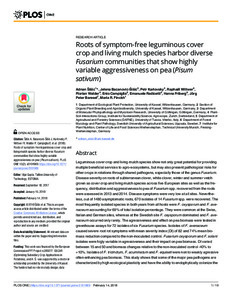View/
Date
2018-02-14Author
Šišić, AdnanBaćanović-Šišić, JelenaKarlovsky, PetrWittwer, RaphaëlWalder, FlorianCampiglia, EnioRadicetti, EmanueleFriberg, HannaBaresel, Jörg PeterFinckh, Maria RenateSubject
630 AgricultureMetadata
Show full item record
Aufsatz
Artikel (Publikationen im Open Access gefördert durch die UB)

Roots of symptom-free leguminous cover crop and living mulch species harbor diverse Fusarium communities that show highly variable aggressiveness on pea (Pisum sativum)
Abstract
Leguminous cover crop and living mulch species show not only great potential for providing multiple beneficial services to agro-ecosystems, but may also present pathological risks for other crops in rotations through shared pathogens, especially those of the genus Fusarium. Disease severity on roots of subterranean clover, white clover, winter and summer vetch grown as cover crop and living mulch species across five European sites as well as the frequency, distribution and aggressiveness to pea of Fusarium spp. recovered from the roots were assessed in 2013 and 2014. Disease symptoms were very low at all sites. Nevertheless, out of 1480 asymptomatic roots, 670 isolates of 14 Fusarium spp. were recovered. The most frequently isolated species in both years from all hosts were F. oxysporum and F. avenaceum accounting for 69% of total isolation percentage. They were common at the Swiss, Italian and German sites, whereas at the Swedish site F. oxysporum dominated and F. avenaceum occurred only rarely. The agressiveness and effect on pea biomass were tested in greenhouse assays for 72 isolates of six Fusarium species. Isolates of F. avenaceum caused severe root rot symptoms with mean severity index (DI) of 82 and 74% mean biomass reduction compared to the non-inoculated control. Fusarium oxysporum and F. solani isolates were higly variable in agressiveness and their impact on pea biomass. DI varied between 15 and 50 and biomass changes relative to the non-inoculated control -40% to +10%. Isolates of F. tricinctum, F. acuminatum and F. equiseti were non to weakly agressive often enhancing pea biomass. This study shows that some of the major pea pathogens are characterized by high ecological plasticity and have the ability to endophytically colonize the hosts studied that thus may serve as inoculum reservoir for susceptible main legume grain crops such as pea.
Citation
In: PLoS ONE. - San Francisco, California, US : PLOS, 2018, 13(2), e0191969, 1-19Sponsorship
Gefördert durch den Publikationsfonds der Universität KasselCollections
Publikationen (Fachgebiet Ökologischer Pflanzenschutz)Artikel (Publikationen im Open Access gefördert durch die UB)
Citation
@article{urn:nbn:de:hebis:34-2018082056123,
author={Šišić, Adnan and Baćanović-Šišić, Jelena and Karlovsky, Petr and Wittwer, Raphaël and Walder, Florian and Campiglia, Enio and Radicetti, Emanuele and Friberg, Hanna and Baresel, Jörg Peter and Finckh, Maria Renate},
title={Roots of symptom-free leguminous cover crop and living mulch species harbor diverse Fusarium communities that show highly variable aggressiveness on pea (Pisum sativum)},
year={2018}
}
0500 Oax 0501 Text $btxt$2rdacontent 0502 Computermedien $bc$2rdacarrier 1100 2018$n2018 1500 1/eng 2050 ##0##urn:nbn:de:hebis:34-2018082056123 3000 Šišić, Adnan 3010 Baćanović-Šišić, Jelena 3010 Karlovsky, Petr 3010 Wittwer, Raphaël 3010 Walder, Florian 3010 Campiglia, Enio 3010 Radicetti, Emanuele 3010 Friberg, Hanna 3010 Baresel, Jörg Peter 3010 Finckh, Maria Renate 4000 Roots of symptom-free leguminous cover crop and living mulch species harbor diverse Fusarium communities that show highly variable aggressiveness on pea (Pisum sativum) / Šišić, Adnan 4030 4060 Online-Ressource 4085 ##0##=u http://nbn-resolving.de/urn:nbn:de:hebis:34-2018082056123=x R 4204 \$dAufsatz 4170 7136 ##0##urn:nbn:de:hebis:34-2018082056123
<resource xsi:schemaLocation="http://datacite.org/schema/kernel-2.2 http://schema.datacite.org/meta/kernel-2.2/metadata.xsd"> 2018-08-20T09:32:39Z 2018-08-20T09:32:39Z 2018-02-14 1932-6203 urn:nbn:de:hebis:34-2018082056123 http://hdl.handle.net/123456789/2018082056123 Gefördert durch den Publikationsfonds der Universität Kassel eng Urheberrechtlich geschützt https://rightsstatements.org/page/InC/1.0/ 630 Roots of symptom-free leguminous cover crop and living mulch species harbor diverse Fusarium communities that show highly variable aggressiveness on pea (Pisum sativum) Aufsatz Leguminous cover crop and living mulch species show not only great potential for providing multiple beneficial services to agro-ecosystems, but may also present pathological risks for other crops in rotations through shared pathogens, especially those of the genus Fusarium. Disease severity on roots of subterranean clover, white clover, winter and summer vetch grown as cover crop and living mulch species across five European sites as well as the frequency, distribution and aggressiveness to pea of Fusarium spp. recovered from the roots were assessed in 2013 and 2014. Disease symptoms were very low at all sites. Nevertheless, out of 1480 asymptomatic roots, 670 isolates of 14 Fusarium spp. were recovered. The most frequently isolated species in both years from all hosts were F. oxysporum and F. avenaceum accounting for 69% of total isolation percentage. They were common at the Swiss, Italian and German sites, whereas at the Swedish site F. oxysporum dominated and F. avenaceum occurred only rarely. The agressiveness and effect on pea biomass were tested in greenhouse assays for 72 isolates of six Fusarium species. Isolates of F. avenaceum caused severe root rot symptoms with mean severity index (DI) of 82 and 74% mean biomass reduction compared to the non-inoculated control. Fusarium oxysporum and F. solani isolates were higly variable in agressiveness and their impact on pea biomass. DI varied between 15 and 50 and biomass changes relative to the non-inoculated control -40% to +10%. Isolates of F. tricinctum, F. acuminatum and F. equiseti were non to weakly agressive often enhancing pea biomass. This study shows that some of the major pea pathogens are characterized by high ecological plasticity and have the ability to endophytically colonize the hosts studied that thus may serve as inoculum reservoir for susceptible main legume grain crops such as pea. open access In: PLoS ONE. - San Francisco, California, US : PLOS, 2018, 13(2), e0191969, 1-19 Šišić, Adnan Baćanović-Šišić, Jelena Karlovsky, Petr Wittwer, Raphaël Walder, Florian Campiglia, Enio Radicetti, Emanuele Friberg, Hanna Baresel, Jörg Peter Finckh, Maria Renate doi:10.1371/journal.pone.0191969 </resource>
The following license files are associated with this item:
Urheberrechtlich geschützt

